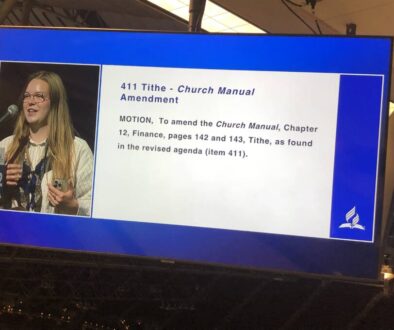Traditional Approach to Bible Supports Ordination for Women Says Historian
by Monte Sahlin
By Keisha McKenzie and Monte Sahlin, April 3, 2014
The question of whether clergy ordination should be extended to women serving as pastors in the Seventh-day Adventist denomination is caught in crossfire between liberals and conservatives, but it is not really about competing methods of interpreting the Bible. This is the history revealed by Dr. Olive Hemmings during the 34th Annual Edward Keough Lectures last weekend (March 28-29) at Washington Adventist University in Takoma Park, Maryland.
A historian, Hemmings traced the changing flow of arguments pro and con as the debate has developed since a union conference in Europe requested clarification in the 1960s. Her first presentation was entitled, “Higher criticism and the Resistance to Women’s Ordination: Unmasking the Issue.
In 1971 the General Conference convened a committee of scholars on the role of women in the Adventist Church. The group included 13 men and 14 women. It studied 19 research papers and the Biblical Research Institute (BRI) proposed a path to women’s ordination which included first, ordination of women as local elders and hiring women as associate pastors; then a pilot program leading to full ordination to the gospel ministry.
During the 1980s, a shift occurred, Hemmings reported. In 1973 Dr. Gerhard Hasel had written a paper on “Man and Woman in Genesis 1-3” which emphasized gender mutuality. By 1989 the same author had published a paper entitled, “Biblical Authority and Feminist Interpretation.” The second paper focused on a “feminist threat” that concerned many church leaders starting in the 1980s. The “feminist agenda” and Bible study methods related to it, “higher criticism” or the historical-critical method, were invoked as a threat at the 1985 General Conference (GC) session in Utrecht, and the request of the denomination's North American Division (NAD) to be allowed to ordain women in its territory was rejected.
Hemmings suggests that the idea of women clergy became a scapegoat for a perceived identity threat. Opponents began to argue that the church and the authority of the Bible were under attack by "liberal feminism" and new approaches to interpreting the Bible. However, the early papers from the BRI in the 1970s, especially Hasel’s had shown that no new interpretative methods were needed to support the theology or policy of women’s ordination.
Hemmings classifies Adventist faith as rooted in the Biblical inerrancy tradition. Where sacramental denominations like the Roman Catholic and Anglican churches limit the sacraments to a male priesthood, those who believe in Biblical inerrancy teach that Jesus consummated the sacraments in His death on the cross and that priests today do not represent Christ on Earth in a sacramental sense, so a woman can mediate the Word of God to the church. Thus, early Adventists accepted the role of Ellen White as a divinely-inspired messenger from God.
Inerrancy sees the Bible as the authoritative source of truth and that the Bible contains no internal contradictions. The historical-grammatical method of Bible study is rooted in these two premises and evolved from the Protestant Reformers’ concern for understanding the Bible authors’ intent and fixing the meaning of the Biblical text.
Hemmings argued that verbal inspiration and proof-texting, “matching text with text without regard for context," pervert the Reformation’s historical-grammatical method. Fundamentalism based on verbal inspiration and proof-texting often results in claiming “no internal contradictions” in the Bible and universalizing selective ancient cultural practices, such as slavery.
In the 1980s some Adventist leaders wanted to align the denomination with the fundamentalist movement against the “modern, liberal” branch of Christianity. Women’s ordination became a symbol of the Adventist-fundamentalist alliance against liberalism, Hemmings stated despite the fact that opposition to women’s ordination is not consistent with the historical Adventist approach to Bible interpretation.
Hemmings argued that women’s ordination has been a casualty of a cultural attack and not a logical or Bible-based one. Women’s ordination came to symbolize something different to the church as mainstream feminism began to critique patriarchy. As fundamentalists began to lump together liberals, patriarchal critiques and higher criticism, and as liberal feminists began to use higher criticism tools and push for women’s ordination, women’s ordination was caught in the “cultural-ideological war [and] the Bible serves as a weapon rather than a means of instruction.”
Within the Adventist denomination, several challenges to traditional belief arose during the 1980s. The sanctuary doctrine, the role of Ellen White, charges of plagiarism, and a six-day creation were questioned as groups like Adventist Forums “closely scrutinized” Adventist doctrines. As the denomination recovered from this period, it moved to resist further challenges.
The cultural conflicts have confused the debate over methods of Bible study. The BRI books on biblical hermeneutics and interpretation stated that the Reformation principle of sola scriptura was under attack and the denomination needed to agree to use methods of Bible study other than higher criticism. But in defense of Ellen White’s authority, it uses higher criticism, including source criticism and genre criticism. Hemmings asked, "Is the church concerned with interpretation? Or with the meaning that results from interpretation?”
In closing, Hemmings noted a deep anxiety about the survival of the denomination that is manifested in opposition to women’s ordination and has made that opposition a symbol of loyalty to some. The BRI has changed its position while insisting on a single hermeneutic to protect the church against the “mortal threat” of liberalism. Interpretations of the Bible are not the real issue, Hemmings concluded.
 Two scholars responded to Hemmings presentation; Dr. Richard Rice, a theologian at Loma Linda University, and Mitchell Tyner, a retired staff member at the GC. “We need historical context to understand historical developments," Rice stated. He summarized Hemmings’ argument that the reversal in church policy on women’s ordination is “guilt by association.” Some reasoned that higher criticism was a tool of religious liberalism and feminism a feature of social liberalism. If the target was liberalism, women’s ordination was collateral damage. He gave other examples in church history, in the 4th and 5th century and again in the 11th century of "unintended consequences" due to reacting to developments without a clear Biblical understanding. Reaction can lead the church into apostasy. Some now perceive the church as “out of touch” because of its exclusion of women from full participation in ordained ministry.
Two scholars responded to Hemmings presentation; Dr. Richard Rice, a theologian at Loma Linda University, and Mitchell Tyner, a retired staff member at the GC. “We need historical context to understand historical developments," Rice stated. He summarized Hemmings’ argument that the reversal in church policy on women’s ordination is “guilt by association.” Some reasoned that higher criticism was a tool of religious liberalism and feminism a feature of social liberalism. If the target was liberalism, women’s ordination was collateral damage. He gave other examples in church history, in the 4th and 5th century and again in the 11th century of "unintended consequences" due to reacting to developments without a clear Biblical understanding. Reaction can lead the church into apostasy. Some now perceive the church as “out of touch” because of its exclusion of women from full participation in ordained ministry.
For Rice, the slippery slope fear, the fear that if women are included, dangers will follow, is a deductive fallacy that doesn’t justify fearful resistance. Rice also challenges the belief that the Bible contains “clear” guidelines that will satisfy the entire world and validate “all church life and thought.” He notes that policy does not always precede practice, as demonstrated in the status and circumcision of Gentiles during the early Church. “The Spirit works in the community,” he said. That is, experience teaches what policy has not yet caught up with, and the church is defined by the Holy Spirit, not merely by shared policy.
Tyner reviewed the historical context for changes in the Adventist church over the years. In 1863, when the GC was started, Reconstruction was initiating the progressive era in the U.S. In 1919, the Adventist church had an historic conference on Bible interpretation, and as a reaction against progressive views expressed by the GC president, there was a change at the 1922 GC session. In the 1920s the Adventist church moved toward fundamentalism during the same time that American society closed immigration and there was conflict over women’s rights. The 19th Amendment passed in 1919-1920 and the Equal Rights Amendment was introduced in 1923.
In 1968, Richard Nixon used "the southern strategy to" get political support and, Tyner stated, that marked the beginning of the “Southernization of the United States.” Among Adventists, the largest union conference in the NAD is now the Southern Union and Southern Adventist University is the center of Adventist conservatism.
During the 1970s, Republican political activisit Phyliss Schlafly promoted “traditional roles” to defeat the Equal Rights Amendment. Among Adventists, Mohaven began the 1970s but in 1979, Jerry Falwell, a Southern Baptist preacher, launched the Moral Majority, an activist conservative movement based on “preservation of traditional values.” By 1980, the Reagan counterrevolution was in full swing, and Adventist religious liberty work shifted from “liberty for all” toward “special interest protections.”
In 1990 and 1995, the GC refused to move forward with women’s ordination despite the recommendations of the early 1970s. In 2005, some Adventists argued that “equality is not a biblical virtue.” There are those who want “to take the church back half a century.” Tyner stated that America is uncomfortable with demographic change today. The church has similarly failed to live up to the implications for equality in the gospel. The church must pay attention to “real problems, real people, real time; That’s what it’ll take. And then we’ll see real progress,” Tyner concluded.
In the question-and-answer time, the question was asked, Is the policy opposition to women’s ordination about cultural differences? Tyner said no. U.S. missionaries exported U.S. culture along with the gospel for most of the 20th century and the rhetorical principle they used to do this was “the unity of the church.” Cultural variance was essential for the health of the church but variance didn’t fit that rhetoric, and so the U.S.-based GC allowed U.S. cultural conservativism to overrule culture in other parts of the world church, as if U.S. values were Christian values. The inverse is happening now that the voting center of the church is outside the U.S. and in the name of “the unity of the church,” non-American values are restraining American church members. If the denomination uses culture to interpret the Bible, readers are forced to ask, “Whose culture should we use?”
Keisha McKenzie is a board member for Adventist Today who attended the Keough lectures and took notes. Monte Sahlin is executive director for the Adventist Today Foundation and edited this article. The other two presentations will be reported in the next few days.



